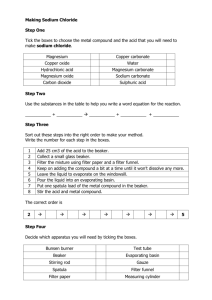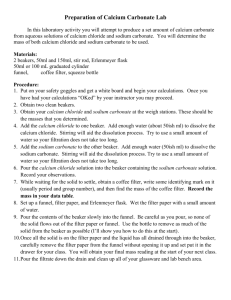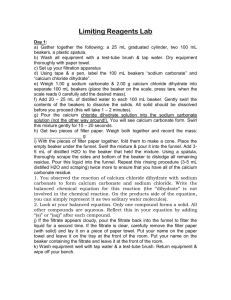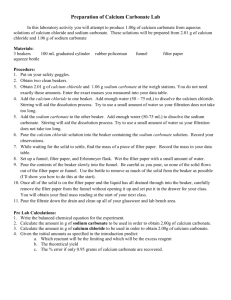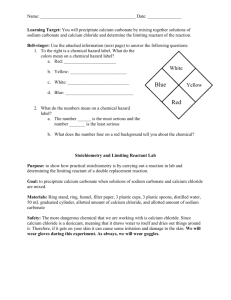Stoichiometry
advertisement
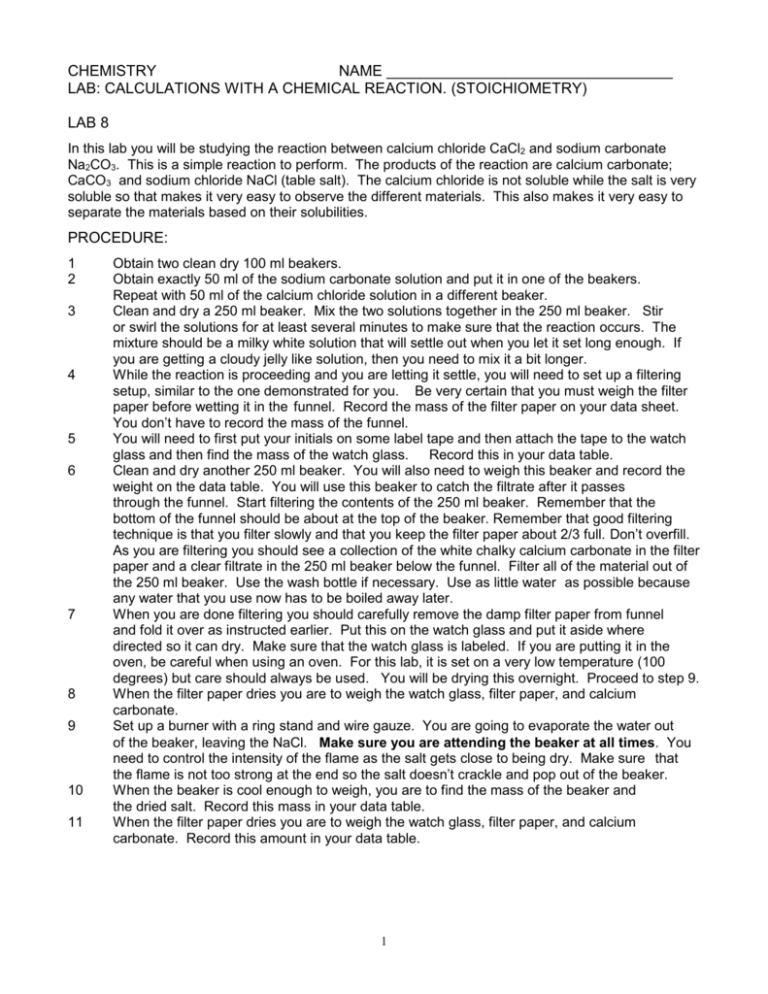
CHEMISTRY NAME __________________________________ LAB: CALCULATIONS WITH A CHEMICAL REACTION. (STOICHIOMETRY) LAB 8 In this lab you will be studying the reaction between calcium chloride CaCl2 and sodium carbonate Na2CO3. This is a simple reaction to perform. The products of the reaction are calcium carbonate; CaCO3 and sodium chloride NaCl (table salt). The calcium chloride is not soluble while the salt is very soluble so that makes it very easy to observe the different materials. This also makes it very easy to separate the materials based on their solubilities. PROCEDURE: 1 2 3 4 5 6 7 8 9 10 11 Obtain two clean dry 100 ml beakers. Obtain exactly 50 ml of the sodium carbonate solution and put it in one of the beakers. Repeat with 50 ml of the calcium chloride solution in a different beaker. Clean and dry a 250 ml beaker. Mix the two solutions together in the 250 ml beaker. Stir or swirl the solutions for at least several minutes to make sure that the reaction occurs. The mixture should be a milky white solution that will settle out when you let it set long enough. If you are getting a cloudy jelly like solution, then you need to mix it a bit longer. While the reaction is proceeding and you are letting it settle, you will need to set up a filtering setup, similar to the one demonstrated for you. Be very certain that you must weigh the filter paper before wetting it in the funnel. Record the mass of the filter paper on your data sheet. You don’t have to record the mass of the funnel. You will need to first put your initials on some label tape and then attach the tape to the watch glass and then find the mass of the watch glass. Record this in your data table. Clean and dry another 250 ml beaker. You will also need to weigh this beaker and record the weight on the data table. You will use this beaker to catch the filtrate after it passes through the funnel. Start filtering the contents of the 250 ml beaker. Remember that the bottom of the funnel should be about at the top of the beaker. Remember that good filtering technique is that you filter slowly and that you keep the filter paper about 2/3 full. Don’t overfill. As you are filtering you should see a collection of the white chalky calcium carbonate in the filter paper and a clear filtrate in the 250 ml beaker below the funnel. Filter all of the material out of the 250 ml beaker. Use the wash bottle if necessary. Use as little water as possible because any water that you use now has to be boiled away later. When you are done filtering you should carefully remove the damp filter paper from funnel and fold it over as instructed earlier. Put this on the watch glass and put it aside where directed so it can dry. Make sure that the watch glass is labeled. If you are putting it in the oven, be careful when using an oven. For this lab, it is set on a very low temperature (100 degrees) but care should always be used. You will be drying this overnight. Proceed to step 9. When the filter paper dries you are to weigh the watch glass, filter paper, and calcium carbonate. Set up a burner with a ring stand and wire gauze. You are going to evaporate the water out of the beaker, leaving the NaCl. Make sure you are attending the beaker at all times. You need to control the intensity of the flame as the salt gets close to being dry. Make sure that the flame is not too strong at the end so the salt doesn’t crackle and pop out of the beaker. When the beaker is cool enough to weigh, you are to find the mass of the beaker and the dried salt. Record this mass in your data table. When the filter paper dries you are to weigh the watch glass, filter paper, and calcium carbonate. Record this amount in your data table. 1 PRELAB QUESTIONS: 1 How many moles of sodium chloride are present in 14 grams ? _______________ 2 How many grams are there in .2 moles of NaF ? _______________ 3 What is a precipitate ? ._________________________________________________________________________ ._________________________________________________________________________ 4 Why is it important to clean the beakers before mixing the chemical in them to make the solutions ? ._________________________________________________________________________ ._________________________________________________________________________ ._________________________________________________________________________ 5 Why is the limiting reagent the one that is used in the mole proportion ? ._________________________________________________________________________ ._________________________________________________________________________ ._________________________________________________________________________ 6 Describe the steps that need to be followed to solve a limiting reagent problem ? Use the back of this sheet and be complete. 7 If in a chemical reaction, the stoichiometry showed that there should have been 1.5 grams of material produced. When you did the lab you only created .25 grams of the material. What is the percent yield ? 8 Write out the balanced equation for this lab and determine how much of each product will be created if 3 grams of each reactant is used to start the lab. What will be in excess and by how much ? 2 DATA TABLE: 1 Volume of the sodium carbonate solution _______________ 2 Mass of the sodium carbonate (given) _______________ 3 Moles of sodium carbonate _______________ 4 Volume of the calcium chloride solution _______________ 5 Mass of the calcium chloride (given) _______________ 6 Moles of calcium chloride _______________ 7 Mass of the filter paper _______________ 8 Mass of the watch glass _______________ 9 Mass of the watch glass, filter paper and calcium carbonate _______________ 10 Mass of the empty 250 mL beaker _______________ 11 Mass of the 250 mL beaker and dried sodium chloride _______________ CALCULATIONS TABLE: 10 Mass of the sodium carbonate _______________ 11 Mass of the calcium chloride _______________ 12 Total mass of all the reactants _______________ What is the balanced equation for this reaction ? Write it below. 12 Moles of calcium carbonate that should have been formed _______________ 13 Mass of calcium carbonate that should have been formed _______________ 14 Mass of calcium carbonate that you formed doing the lab _______________ This is the value that you got in #9 minus the watch glass and filter paper 15 Moles of sodium chloride that should have been formed _______________ 16 Mass of sodium chloride that should have been formed _______________ 17 Mass of sodium chloride that you formed doing the lab _______________ This is the value that you got in #11 minus the mass of the 250 mL beaker 18 What is the percent yield of calcium carbonate (show your work) 3 _______________ CALCULATIONS PAGE: Use this page to show your work on any calculation that you had to do. Label them so I know which work goes with which calculation. Failure to clearly label the work will result in points lost.. 4 QUESTIONS: 1 What material is in excess and by how many grams ? Show your work below. 2 According to the stoichiometry of the problem, how many grams sodium chloride should have been created in the lab ? How many grams of calcium carbonate ? 3 What is the percent error for the amount of calcium carbonate created in the lab ? Show your work here to receive credit. 4 Why didn’t we have to measure out the mass of the water in the lab ? ._________________________________________________________________________ ._________________________________________________________________________ ._________________________________________________________________________ 5 Write out the balanced equation again and explain how the law of conservation of matter is followed in this reaction. 6 If the material that we were making were gases, what is the number of the conversion that tells us how many liters per mole of any gas ? __________________________ 7 On a separate sheet of paper you are to record all of the sources of error. 5 INSTRUCTIONS AND GUIDELINES FOR STOICHIOMETRY LAB For this lab you will be working with a partner. By the end of the first day you are to mix the solutions, filter and evaporate the water away. You will let the filter paper dry and record the final mass later. It is absolutely to keep the equipment neat, clean and in you bin. At 5 minutes to go in the period your bins will be checked and if equipment is missing you will lose points. The list of equipment that should be in your bin is as follows: 2 1 1 1 1 100 ml beakers wash bottle funnel forceps bunsen burner 2 1 1 1 1 250 ml beaker watch glass wire gauze ring clay triangle 1 glass stirring rod 1 tongs 1 rag The list of equipment that should be in the small bin for the entire peninsula is as follows: 1 a flask of Calcium chloride solution 1 a brush to clean glassware 1 wax pencil 1 a flask of Sodium carbonate solution 1 sparker for the burner 1 filter paper REMEMBER that the rings are stored near the windows. REMEMBER that the balances to mass out the materials will be at each peninsula. Use only the one at your peninsula. REMEMBER that you are to show your work on the calculations page. This will help you get some partial credit in case of error. You are being graded on the accuracy of your answer. If the lab is done well then you should be able to get a high percent yield and a low percent error. This does not mean that you have to have zero percent error to get full credit. Also remember that explaining your error is often just as important as the amount of error itself. 6
